
- SOC FPX 2000 Assessment 2 Diversity and the Media.
Diversity and the Media
Media is one of the most crucial institutions of society due to the influence it has on one’s identity as well as perception of society. Such analysis of the media will help us to find out how media portrays and perpetuates social norms, values, and relations in society. It also assists people in understanding where the media operates in terms of culture and social relations, and it also shows practices of representation and the distribution of power.
Analyzing Sociological Theories
The conflict perspective, Weber’s theory of inequality, and Park’s race relation cycle give a comprehensive approach to determining whether racial diversity and social inequality are realities in the United States of America.
Conflict Perspective
The Conflict perspective of Sociology believes that society is a structure built on limited resources. Hence, individuals fight for resources, resulting in social injustice and class differences. This theory can be of tremendous help when studying racial diversity in the United States as it explains the structural and systematic nature of racial discrimination.
Yemane (2020) also noticed that there is stereotype hiring discrimination, with Blacks being the most affected as compared to whites. In light of this research, it is argued that power and resources are skewed within a setting, hence strengthening the conflict perspective anchored on race.
Weber’s Theory of Inequality
Weber’s theory of inequality suggests that social stratification is based on three factors: people with class, status, and power. This theory is quite helpful in analyzing racial diversity in the US since it will assist one in unravelling the role of race in relation to other factors that contribute to social problems. Corra et. al, (2022) revealed that based on race and social class, Black and low-income students are less likely to attend college, other things being equal.
Park’s Race Relation Cycle
Park’s race relation cycle theory is worth mentioning, as it states that race relations in society progress through the cycle of contact, competition, accommodation, and assimilation. This theory will assist in unraveling racial diversity in the United States because it can explain the historical and contemporary African American struggles for civil rights as well as integration.
The findings of the recent study indicate that there is improvement in some of the areas, but the situation is not encouraging. In a survey of the influence of racism and prejudice by Visintin et al., 2019 the authors revealed that increased exposure to people of other races reduces prejudice. It is for these reasons that this research aligns with Park’s theory, which demonstrates that social interaction can assist in the reduction of prejudice and positive intergroup relations.
Effect of the Article on Policy and Power: An Analysis
In other ways, the article can influence policies as well as power in the following manners. First, because the article discusses the fact of the existence of the problem of racial inequality in America and provides a view of the shortcomings of the system in addressing it, thus the article may contribute to mobilizing people to support the solution in the form of policy measures.
For instance, the article acknowledges the fact that only legislation can solve the problem of systematic change within institutions, which requires change that might comprise the criminal justice system, the educational system, and funding for social institutions.
Second, as the article will strive to pressure corporate and institutional oversight, decisions, and voices for corporate, institutional, and multicultural inclusion, it will help alter the power relations. PWC highlights to us that while many firms have come out to express their support for the racial justice course, more needs to be done about the course so that the words coming out of the firms are followed by the deeds.
This makes the article effective in raising the bar of accountability and representation and forcing companies and institutions to act on the reality of racism. Scientific evidence illustrates that media influence any given population and its policies mainly concerning race and racism or any form of injustice.
Supporting Scholarly Articles
Kilgo and Mourão (2021) reported that race issues disclosed in mainstream media positively affect the perception of racism and policies targeting it by the public. It was also observed that when the press attributes racism to systemic factors, for instance, institutional racism, the subsequent support for the given policies, which are looked at as aiming at eradicating racism, was also higher. Similarly, Boudreau et al. (2022) also revealed that watching such programs depicting police brutality against ethnic minorities can shift the general public’s perception of police accountability and their approval of police reform.
The Portrayal of the Minorities and Dominant Groups in the Article
Overall, the article is written critically when it comes to the status of minorities and dominant groups; the author is carefully showcasing how racism is knitted into the fabric of American society, causing grand disparities between the white populace and the people of colour.
Portrayal of Minority Groups
It enumerates some facts and figures as well as the research and polls that appeared to show how white Americans started to experience a worse quality of life compared to people of colour in terms of access to health care, education, and even wealth. For instance, the article indicates that while the black population is at triple the risk of the white population getting COVID-19-related deaths, the racial wealth gap has burgeoned in the course of the last few decades.
Such presentation of minorities as suffering from higher risks of racial injustices is well-supported by research. For instance, Daly et al. (2020) identified that Black employees continuously earn less than their white counterparts, and this is not putting into consideration factors such as level of education and experience. What they also discovered was that Black employees face higher rates of unemployment and underemployment and have limited access to health care and pensions.
Portrayal of Dominant Groups
According to the article, the majority, in particular the white Americans, have been beneficiaries of racism, especially to the detriment of minorities. For instance, the article compares the situation of white Americans and people of colour in the US. It states the following: white Americans are privileged and have quality health care, higher education, and more incredible wealth, while people of colour endure poverty, health inequity, and discrimination in the criminal justice system. It should also be noted that different dominant groups are portrayed in the studies as well.
For instance, in their studies, Jardina (2019) suggested that white people in the United States have higher levels of perceived relative status and power than people of colour and also suggested that white people as a group underestimate the level of racial equality.
Data Supporting the Central Tenets of the Article
Shown below are the main postulates of the article under analysis: Americans Have Learned to Talk About Racial Inequality. But They’ve Done Little to Solve It. Race Inequality is Endemic and Impacts the First Nations People and Other Persons of Colour Unfairly. The inequality based on race in America is deeply rooted in the society it is; however, it remains a social evil that has been prevalent in the country and has been experienced by people of colour.
Enders and Scott (2018) also suggest that racial resentment, which they maintain is a perennial political element in America, is positively linked to views on social policy. The authors provide arguments for the fact that racial hatred influences whites’ views on social policies that are believed to benefit Africans, and this impact is any more potent as compared to political party affiliation or political ideology.
Big businesses and organizations, particularly called institutions, must support diversity and representation. Employer organizations and other institutions bear the responsibility for driving the increase in the better representation and voice of diverse groups.
There is considerable research indicating that diverse teams are more creative and tend to produce higher organizational performance than non-diverse teams (Chaudhry et al., 2021). The authors state that diversity and inclusion should hence be viewed as a business necessity because for one to prosper, one must be willing to produce a diverse workforce and be willing to listen to that diverse workforce.
Conclusion
This assessment focused on an article that was centred on race and race relations in America and its effects on politics and authority. In particular, the article highlights the importance of system change and the demand for a better representative sample.
Furthermore, the assessment unveiled the stubborn realities of racially motivated discrimination in America today and the critical part that policymakers and leaders within institutions play in redressing this. Finally, they included an evaluation of articles in support of the postulates contained in the article. Read more about our sample SOC FPX 2000 Assessment 1 Cultural Diversity and You for complete information about this class.
References
Boudreau, C., MacKenzie, S. A., & Simmons, D. J. (2022). Police violence and public opinion after George Floyd: How the black lives matter movement and endorsements affect support for reforms. Political Research Quarterly, 75(2), 106591292210810.
https://doi.org/10.1177/10659129221081007
Chaudhry, I. S., Paquibut, R. Y., & Tunio, M. N. (2021). Do workforce diversity, inclusion practices, & organizational characteristics contribute to organizational innovation? Evidence from the U.A.E. Cogent Business & Management, 8(1), 1947549. Tandfonline.
https://doi.org/10.1080/23311975.2021.1947549
Corra, M., Carter, J. S., & Carter, S. K. (2022). The interactive impact of race and gender on high school advanced course enrollment. Journal of Negro Education, 80, 33–46.
Daly, M. C., Hobijn, B., & Pedtke, J. H. (2020). Labour market dynamics and black–white earnings gaps. Economics Letters, 186.
https://doi.org/10.1016/j.econlet.2019.108807
Enders, A. M., & Scott, J. S. (2018). The Increasing Racialization of American Electoral Politics, 1988-2016. American Politics Research, 47(2), 275–303.
https://doi.org/10.1177/1532673×18755654
Jardina, A. (2019). White Identity Politics. Cambridge University Press.
https://doi.org/10.1017/9781108645157
Kilgo, D. K., & Mourão, R. R. (2021). Protest coverage matters: How media framing and visual communication affects support for black civil rights protests. Mass Communication and Society, 24(4), 576–596.
https://doi.org/10.1080/15205436.2021.1884724
Visintin, E. P., Green, E. G. T., Falomir-Pichastor, J. M., & Berent, J. (2019). Intergroup contact moderates the influence of social norms on prejudice. Group Processes & Intergroup Relations, 23(3), 418–440.
https://doi.org/10.1177/1368430219839485
Yemane, R. (2020). Cumulative disadvantage? The role of race compared to ethnicity, religion, and non-white phenotype in explaining hiring discrimination in the US labor market. Research in Social Stratification and Mobility, 69, 100552.
